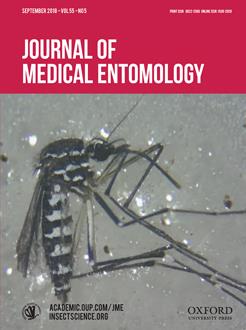Salmonella Typhimurium (Le Minor and Popoff 1987; Enterobacteriales: Enterobacteriaceae) is a pathogen that causes gastroenteritis in humans and can be harbored by house flies. Factors influencing excretion of S. Typhimurium from infected flies have not been elucidated but are essential for assessing transmission potential. We determined the persistence and excretion of a green fluorescent protein (GFP) expressing strain of S.Typhimurium from house flies. Individual male and female flies were fed either sterile Luria-Bertani (LB) broth (controls) or cultures of “high” (~105 colony forming units [CFU]) or “low” (~104 CFU) doses of bacteria (treatments). Bacterial persistence was determined over 16 h by culturing whole-fly homogenate. Both sex and dose affected persistence between 6 and 12 h postingestion. In a separate experiment, fly excretion events were monitored during this time interval and excreta droplets were individually cultured for bacteria. Female flies had more excretion events than males across treatments. We observed interactions of fly sex and bacterial abundance (dose), both on the proportion of Salmonella-positive droplets and the CFU shed per droplet (CFU/droplet). In the low-dose treatment, males excreted a greater proportion of positive droplets than females. In the high-dose treatment, males excreted more CFU/droplet than females. High-dose male flies excreted more CFU/droplet than low-dose males, but low-dose females excreted more CFU/droplet than high-dose females. Irrespective of sex, low-dose flies excreted a greater dose-adjusted CFU (CFU droplet/CFU fed) than high-dose flies. This study demonstrates that both bacterial abundance and fly sex may influence excretion of bacteria from flies, and should be considered when assessing the risk of house fly transmission of pathogens.
How to translate text using browser tools
11 April 2018
Effects of Bacterial Dose and Fly Sex on Persistence and Excretion of Salmonella enterica serovar Typhimurium From Adult House Flies (Musca domestica L.; Diptera: Muscidae)
Dana Nayduch,
Klara Zurek,
Jessica L. Thomson,
Kathleen M. Yeater
ACCESS THE FULL ARTICLE
It is not available for individual sale.
This article is only available to subscribers.
It is not available for individual sale.
It is not available for individual sale.

Journal of Medical Entomology
Vol. 55 • No. 5
September 2018
Vol. 55 • No. 5
September 2018
bacteria
excreta
Musca domestica
pathogen
vector




